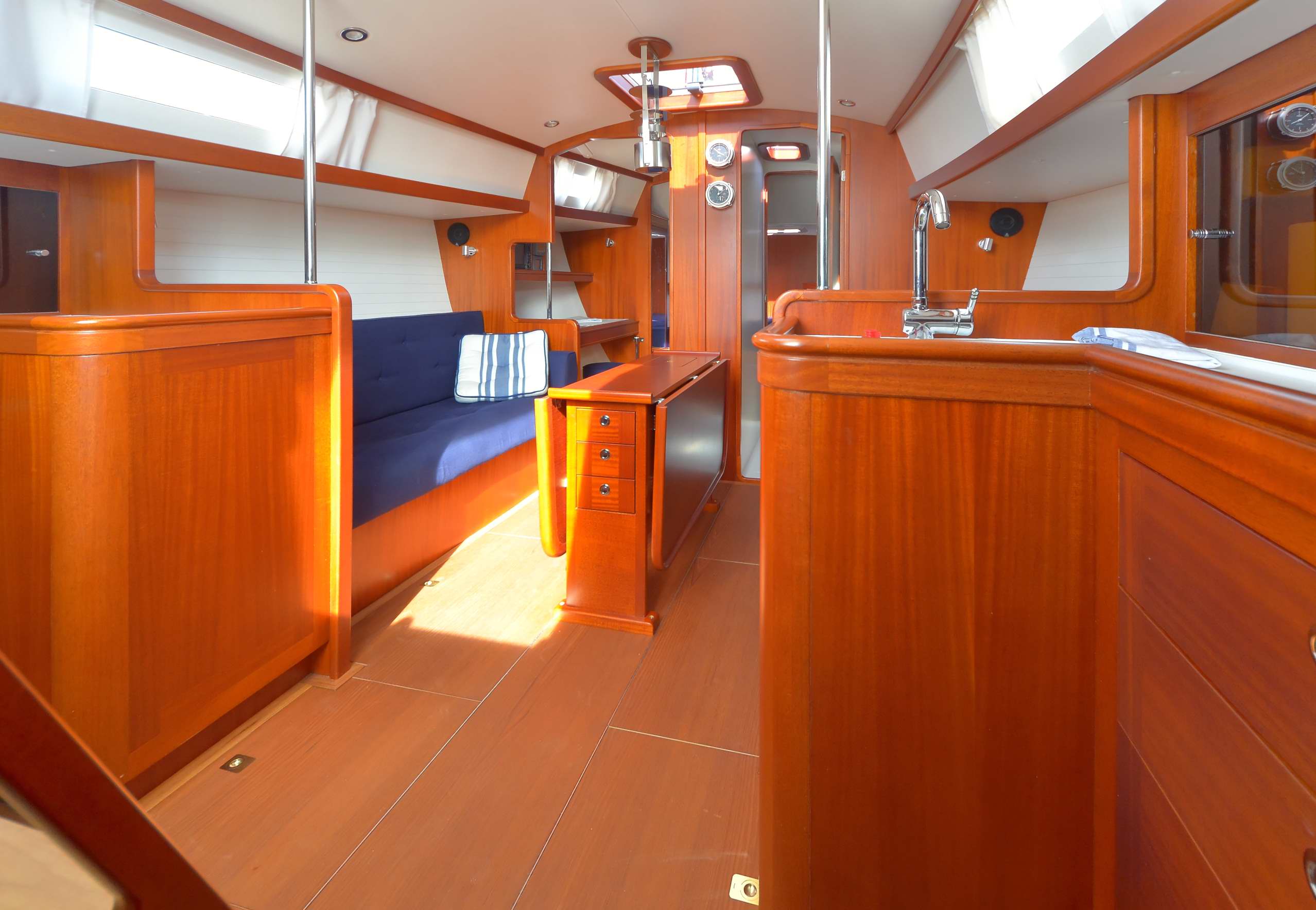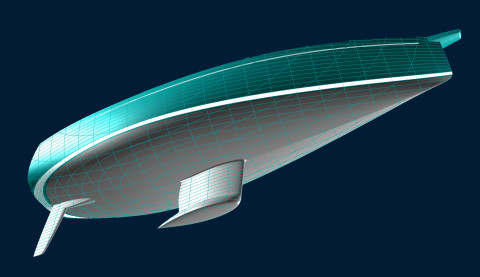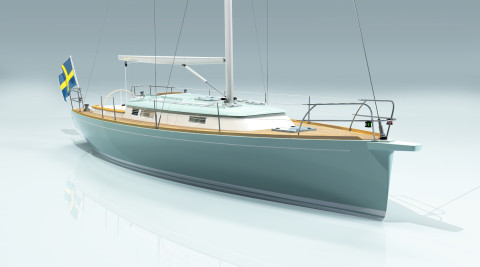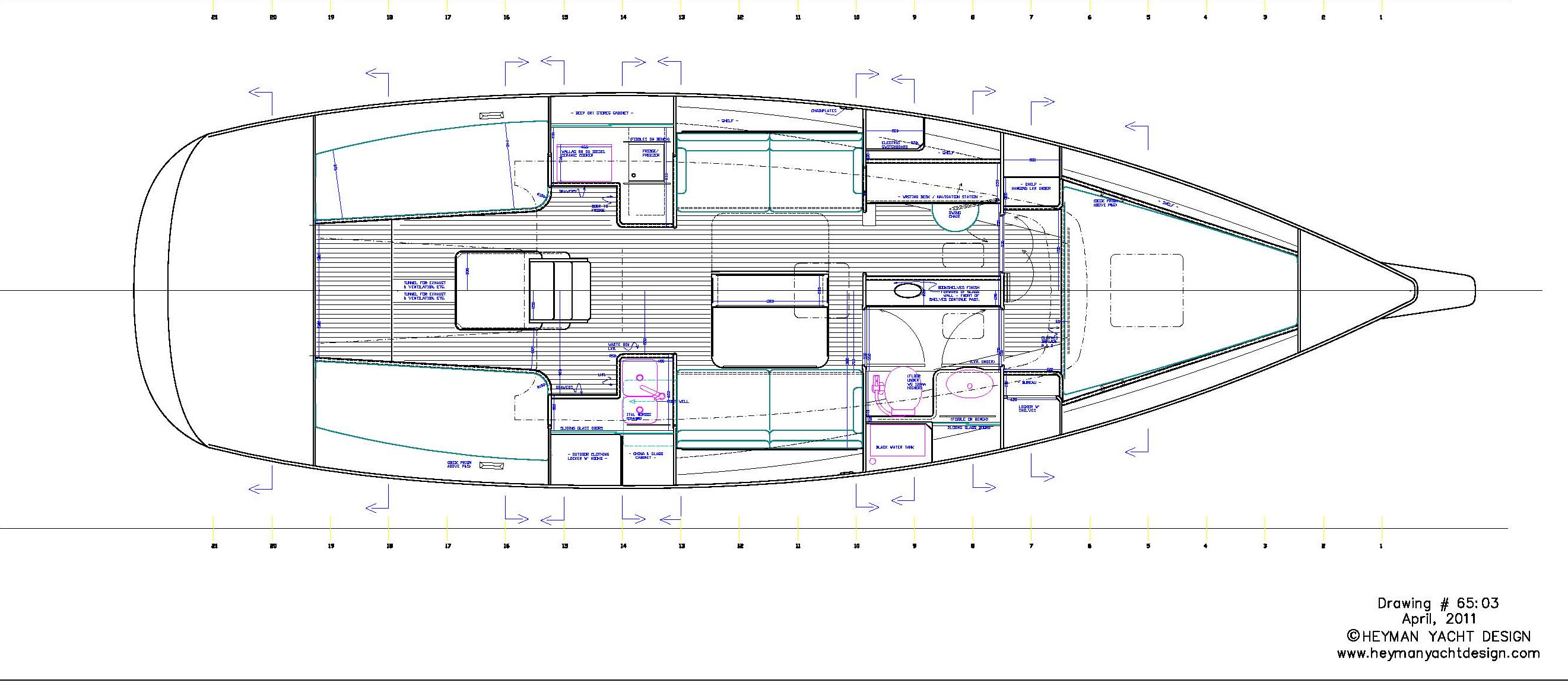Update:
We have published a number of images of the Celeste 36 here
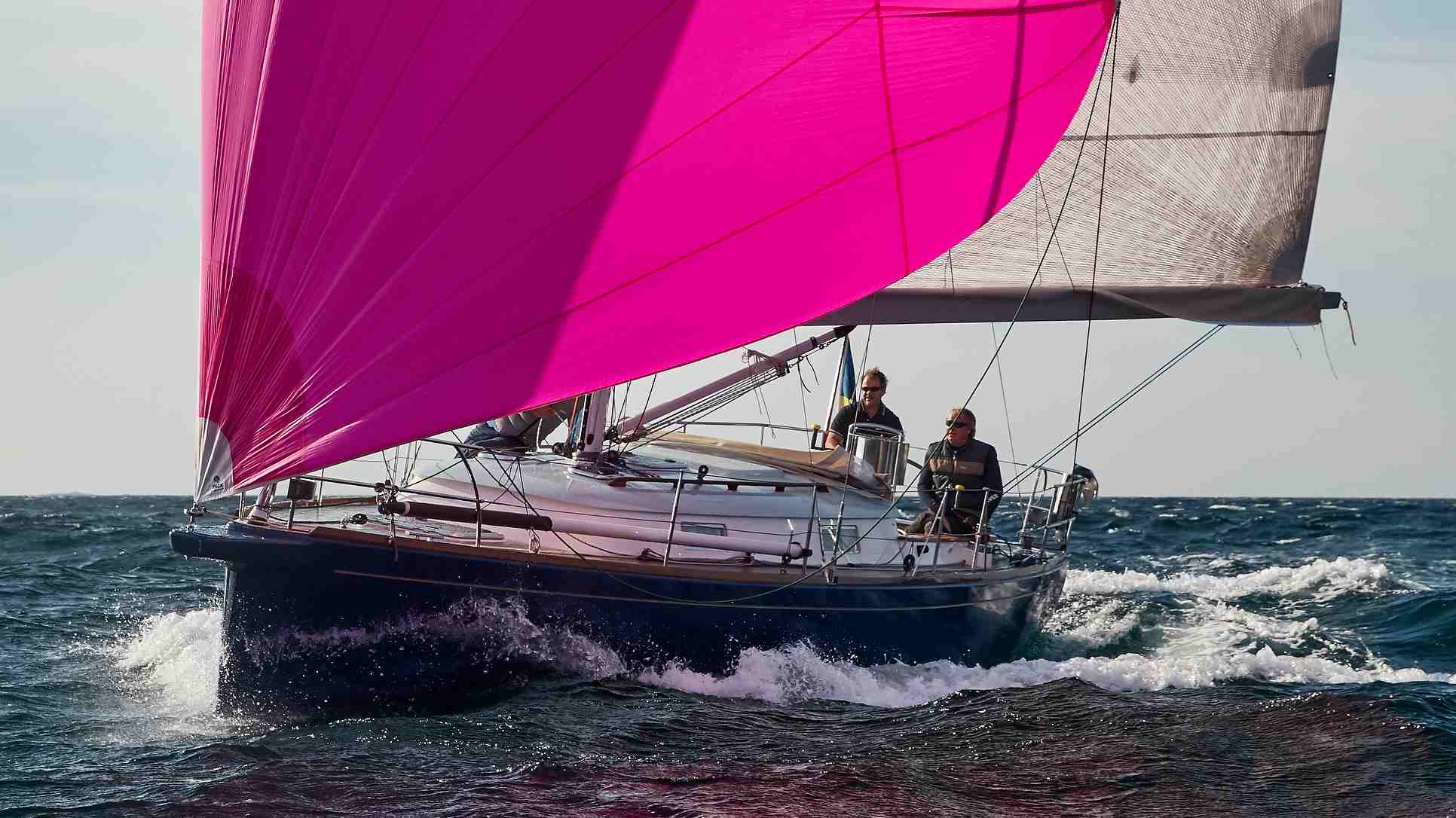
The Celeste 36, what is she?
A Daysailer…?
Maybe. She is meant for summer days, and is easily handled by one person only. There is an emphasis on a big, comfortable cockpit. During the first test sail, with 9 people in the cockpit, there was plenty room for everyone.
A Racer…?
Well, possibly – the first client is a sailor who has been racing keelboats for half a century with some success – mostly offshore racers and Dragons. Will she deliver any racing results? – at the moment, all we know is that she certainly is eager to do her best. She is stiff, responsive, with good straight-line speed.
A Cruiser…?
Not in the usual sense of the word, because she doesn’t have that much stowage. We have thought of her more as a coastal cruiser. During her development we have called her, in sports car terms, a 2+2. She will take good care of a couple, with children or occasional friends, on a week-long cruise. Her draft is not excessive, handling is a doddle and her manners civilized.
Can you rely on common knowledge?
If you’re curious, you will always find another cove to explore…
The shapes of almost all sailboats conform strictly to recommendations based on research in Delft, Holland. Naval architects look at numbers like the Prismatic Coefficient, which describes the distribution of hull volumes. We have researched slightly different hulls and found there is a lot to be gained by going beyond those recommended ratios. The Celeste 36 is sharper forward, under water, than any other boat of similar proportions. This makes her faster, especially in a seaway.
New hull shapes are being developed now. I am not talking about styling features or straight stems and broad transoms; everyone has these, but more subtle aspects.
Basically, I see two ways of going beyond the box that ordinary sailboats have been stuck in during the past decade. One way is making hulls with extreme beam aft and some clever managing of the heeled displacement, like the Open 40s.
The other route is a boat like the Celeste 36 which in its own way is just as radical, but without any intention of being an explicitly extreme design. ‘Subtly radical’, does that make sense?
What is the catch?
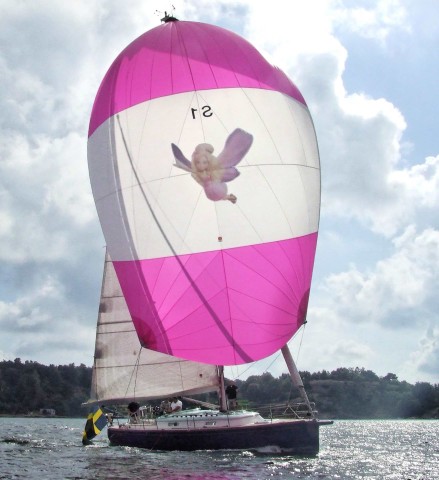
Celeste 36 rig
For any new concept there is almost always a flip side but, with this one, we see no drawbacks.
Apart from the different hull shape, the idea has been to fit a bigger sail area without increasing mast height, in order to make a more powerful, stiff boat. Strangely, the different hull and the different sail plan are a perfect match for each other.
In ordinary boats, the mast has to be a little too far forward, and the boom has to end quite some distance forward of the stern, or the boat will be impossible to steer – in fact, many are impossible to steer anyway!
This is exactly where we added sail area to the Celeste 36, far aft. But instead of ruining her handling, we were able to improve both steering and manoeuvring.
Think of it as a dart, or an arrow. With the wings set far back, it will go in the desired direction. With the wings of a sailboat further aft, both keel and sails, she will steer forward and be in control.
And she will do so with more power and more speed, thanks in part to this very sharp bow, cutting through waves.
Is the difference academic, or is it real?

Celeste 36 bow
The difference may not be huge, but it is very real.
We have had the concept evaluated in two different studies – there is a 4 percent gain in VMG between any ordinary modern boat and this kind of design. Both may look more or less the same, and they have identical measurements.
The speed gain is both upwind, and downwind. Our new designs have an easier motion, more resistant to pitching. And I am not sure whether our boats are able to broach – in fact, none of them has had a broach, ever.
Still, she looks rather conventional?

Celeste 36
Well, she is not extreme. Hopefully, the Celeste will be owned by people who will see her as a member of the family and keep her for many years, so we tried to give her a low key, understated character. But, still, a character…
We don’t do any market research or any of that stuff the big producers do but I must admit I have been inspired by the American daysailers of later years. The concept is lovely, and so many people nowadays are only out for a few days anyway. At the same time I found these boats anachronistic with their short waterlines, huge displacement and lack of space inside. I figured, these boats are for the 60- or 70-years-old, why not make a boat for those who are 40 or 50?
So, I guess, she may be seen as conventional. But there are little oddities. Like the overhanging roof – in the past, boats would have an ‘eye brow’, a wood strip above the windows, to give them more of a determined look. I wanted to create that expression, but in a modern way.
But the roof edge also serves as a place for a row of LED deck lights (white in port, red for night sailing, by the way).
Deck
The overhanging roof is also a key element behind the deck layout. We wanted to create an utterly clean deck, which called for all control lines and sheets to be led in channels under the roof. With this roof, we did not have to use any glassed-in, potentially leaking tubes: instead, we made it an intricate, accessible, water tight part of the deck moulding.
By going this route, we were able to allow the lines to be led all the way to the rope jammers, invisibly, and to create a perfect position of the jammers in relation to the winches. The coils of line can then be tucked away in rope lockers. The main halyard, for example, is led to an electric winch near the helmsman and neatly put away.
The ambition to keep a clean deck is also helped by the electric under-deck Seldén jib furler and the electric primary winches. Boat #1 does not have an anchor arrangement – this will otherwise be arranged through the bow platform. Instead, this first boat has a boarding ladder inside the platform, for going ashore, tied up to an island, Scandinavian style.
All contraptions on a boat should serve at least two purposes. In the case of the bow platform, it is also used for setting the gennaker or Code headsail.
Rig

Carbon rig, Park Avenue boom
The mast is a beautiful autoclave-moulded carbon fibre affair by Marstrom and, with the shrouds set at the outer edge of the boat, allows a slender mast section and a simple, swept two-spreader rig.
The boom is the first Marstrom carbon fibre Park Avenue boom for this size of boat, developed specially for the Celeste 36. The goal, again, is to keep all sail handling as clean and simple as ever possible – this boom stows the mainsail as it is lowered. Just pull the zipper and the cover is on.
Cockpit

Celeste 36 cockpit
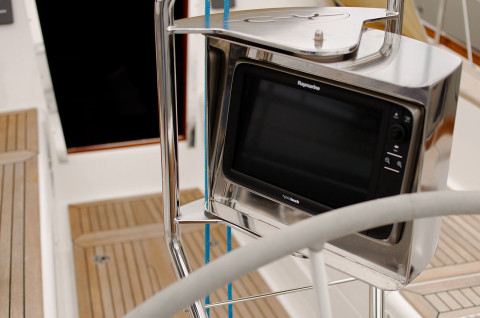
Celeste 36 plotter
For the size of boat, the cockpit is huge. The boat is handled from the helmsman’s position, apart from reef and trim lines, so the forward part of the cockpit is for enjoying the day – the seats are a little wider and longer, and the backrests curved for comfortable seating in all four corners. A table can be set up for alfresco dining.
The very wide transom door is a stupid simple configuration – so simple that it probably has not been done before. When folded down, it forms part of an open cockpit with an even bigger floor, with direct access to the swimming ladder. The Celeste 36 can be sailed with the cockpit open or closed, depending on conditions and preferences.
For single-handed sailing in cluttered Scandinavian waters, a good chart plotter is a great help so we developed a housing which the helmsman can simply turn towards him or her, when sitting to port or starboard.
Finding your way below
In a Day Sailer, other functions are emphasized than in an out-and-out cruiser. When creating the Celeste 36’s interior layout, we have not tried to be different for difference’s sake, instead, it is more the result of an analysis of what functions are most important. But no matter the reason, slightly different she is.
Aft, under the cockpit, are simply two quarter berths, with curtains for privacy, and space for stowing a few bags aft of the engine. Access to this area is made simple by lifting the cockpit floor.
The galley is divided, with the cooking to port and the sink to starboard. There is no oven and no gimballed cooker. An oilskin locker lurks behind the galley on the starboard side.
The main cabin is in the widest part of the boat and has a fixed drop-leaf table. It extends forward on the port side into an office – a place for sending an email, looking at a chart, and for keeping the ship’s library, with more than 3 metres of bookshelves. Space enough for you intellectual people.
Forward, there is a double stateroom, with private access to the w.c. / shower.
The heads is interesting in that, at night, it can be used discretely either from the stateroom or the main cabin. But also, when not in use, both doors can be left open, concealing the w.c and forming a passage to the forward stateroom. The passage is useful if, for example, someone is working in the office but – perhaps more important – it opens up the interior space.
Because, most of all, we have tried to create an open interior, with plenty of natural light, a special ‘ambience’, and sight lines from bow to stern.
To help ventilation, the Celeste 36 has two opening portlights above the galley, set behind glass louvers so you can see out – still, with the help of the louvers, they can be left open most of the time and even if it is raining. The first owner wanted his boat to be as clean as ever possible, therefore, these were omitted on hull #1.
Any alternative versions?
For racing, a deep T-keel version.
For more extended cruising, a more conventional layout with a bigger galley on one side, a small aft cabin opposite and more stowage.
But many things can be altered and added – the Celeste 36 is built in small numbers, by specialized yards, and her price will be correspondingly high.
How is she put together?
The Celeste 36 is built with a vacuum infusion of Vinylester and multi-directional glass on a Divinycell core. Most bulkheads are laminated using the same technique. There are two transverse main bulkheads joined by another longitudinal one which, together with hull and deck, form a stiff box structure to support the rig.
The keel area is a substantial single laminate, with floors and girders carefully built up and laminated in place, on a Divinycell core. Between the bilge and low-placed lead keel there is a glass laminate keel, solid right through. Tap it and it rings like a church bell.
The entire construction is made for a trouble free, long life which means we have avoided things like an intermediate welded keel, or a too deep and inaccessible bilge, or sandwich laminates built on a balsa core. The rudder stock, for example, is a reliable, tapered solid Jefa aluminium stock. In order for her topsides and cabintop roof to keep their gloss, the boat is Awlgripped as standard.
For hull #2, things like hatches and the roof may be built of carbon fibre laminates. The carbon rig is part of her standard specification.
Dimensions:
LOA 11,55 m (38 ft)
Hull Length 10,98 m (36 ft)
DWL 10,21 m
B max 3,39 m
Draft 1,83 m
Displacement 6400 kg
Ballast 2500 kg
Sail area, true 77,3 sq.m.
Main 45,0 sq.m.
Jib 32,3 sq.m.
Gennaker 85 sq.m.
Spinnaker 108 sq.m.
Engine, Volvo Penta D1-30 29 hp
Ratios:
D/L ratio 170
SA/D ratio 22,4
Waterline entry angle 14,6 degrees
Details and specifications subject to change without notice



